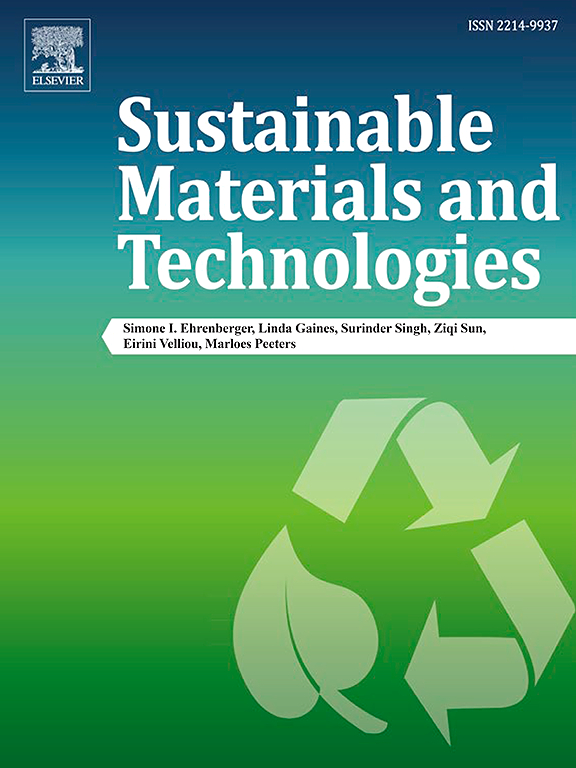研究镧系透辉石氧化物对活性炭布基柔性超级电容器电极材料 NiCo2S4 的影响
IF 8.6
2区 工程技术
Q1 ENERGY & FUELS
引用次数: 0
摘要
我们研究了不同la基钙钛矿纳米结构(LaMO3,其中M表示Ni, Co和Fe)与NiCo2S4 (NCS)作为电极材料的组合对柔性超级电容器(FSC)性能的潜在增强。将NCS与LaMO3按1:1的M比混合,得到NCS/LNO、NCS/LCO和NCS/LFO三种复合电极材料,分别涂覆在活性炭布(ACC)上制备柔性电极。采用不同的物理化学表征技术对合成材料的结构和形态特征以及所制备的acc基电极的元素含量进行了检测。复合电极的电化学性能优于NCS,在1 A/g电流密度下,NCS/LNO、NCS/LCO、NCS/LFO和NCS的初始容量分别为585、500、410和330C/g。在4 a /g条件下,NCS/LNO在10,000次循环后的电量维持率为87.5%,高于NCS/LCO(82%)、NCS/LFO(76.4%)和NCS(71%)。随后,以上述电极为阳极,活性炭(AC)为阴极,构建了四个不对称SC器件。与其他三种器件相比,NCS/LNO/ AC器件大大提高了功率和能量密度,最高可达86.6 Wh。功率密度为400w .kg−1,高于预期的39.5 Wh。即使在16kw .kg−1的高功率密度下,也能保持高功率。此外,当在4 a /g电流密度下进行10,000次循环时,该设备保持了85%的容量。此外,基于NCS/LNO的FSC器件在弯曲变形下仍能保持其电化学性能。这凸显了NCS/LNO可以被视为柔性能源系统和可穿戴电子产品的潜在材料。本文章由计算机程序翻译,如有差异,请以英文原文为准。

Investigating the influences of lanthanum-based perovskite oxides on NiCo2S4 as electrode material in activated carbon cloth-based flexible supercapacitors
We investigated the potential enhancement of flexible supercapacitor (FSC) performance through the combination of different La-based perovskite nanostructures (LaMO3, where M denotes Ni, Co, and Fe) with NiCo2S4 (NCS) as electrode material. NCS was mixed with LaMO3 at a 1:1 M ratio and three composite electrode materials of NCS/LNO, NCS/LCO, and NCS/LFO were obtained, which were individually coated on the activated carbon cloth (ACC) to prepare flexible electrodes. The structural and morphological features, along with elemental content of the synthesized materials and the prepared ACC-based electrodes were examined using different physicochemical characterization techniques. The composite electrodes exhibited superior electrochemical performance than NCS, in which NCS/LNO, NCS/LCO, NCS/LFO, and NCS exhibited an initial capacity of 585, 500, 410, and 330C/g, respectively, under an applied 1 A/g current density. NCS/LNO featured a charge maintenance of 87.5 % at 4 A/g after 10,000 cycles, which was higher than that achieved for NCS/LCO (82 %), NCS/LFO (76.4 %), and NCS (71 %). Subsequently, four asymmetric SC devices were constructed with the aforementioned electrodes serving as the anode and activated carbon (AC) as the cathode. In comparison to other three devices, the NCS/LNO//AC device greatly improved power and energy density, reaching a maximum of 86.6 Wh.kg−1 at a power density of 400 W.kg−1, which was higher than the desired 39.5 Wh.kg−1 even at a high-power density of 16 kW.kg−1. Moreover, when subjected to 10,000 cycles at a current density of 4 A/g, this device maintained 85 % of its capacity. Furthermore, the FSC device fabricated based on NCS/LNO could retain its electrochemical performance under bending deformation. This highlights that NCS/LNO can be regarded as a potential material with great promise for flexible energy systems and wearable electronics.
求助全文
通过发布文献求助,成功后即可免费获取论文全文。
去求助
来源期刊

Sustainable Materials and Technologies
Energy-Renewable Energy, Sustainability and the Environment
CiteScore
13.40
自引率
4.20%
发文量
158
审稿时长
45 days
期刊介绍:
Sustainable Materials and Technologies (SM&T), an international, cross-disciplinary, fully open access journal published by Elsevier, focuses on original full-length research articles and reviews. It covers applied or fundamental science of nano-, micro-, meso-, and macro-scale aspects of materials and technologies for sustainable development. SM&T gives special attention to contributions that bridge the knowledge gap between materials and system designs.
 求助内容:
求助内容: 应助结果提醒方式:
应助结果提醒方式:


